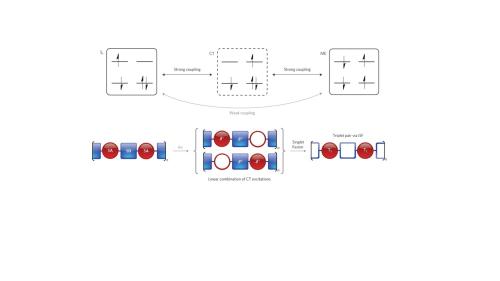Technologies Available for License
Categories: advanced materialsenergy
2014-008: Organic oligomers and polymers for efficient intramolecular singlet fission
Invention: 2014-008
Patent Status: U.S. Patent Number 10,636,974 was issued on April 28, 2020
For technical and licensing related questions, email tcp@bnl.gov.
Summary

A design strategy for intramolecular singlet fission mediated by charge-transfer states in donor–acceptor organic materials.
This joint invention between BNL and Columbia University provides generalized molecular compositions for the development of tunable materials for high efficiency (> 33.7%) Photovoltaic (PV) devices based on multiple exciton-generation processes. The inventive materials include novel organic oligomers and polymers designed to exhibit strong intrachain donor-acceptor interactions and deliver intramolecular singlet fission, where triplet populations can be generated in very high yields of, e.g., 170% or more. The fundamental attributes of this invention can lead to the development of new fission-capable materials with tunable electronic structure, as well as a deeper fundamental understanding of Multiple Exciton Generation (MEG) to improve the performance of Organic Photovoltaics (OPVs).
Description
Our invention demonstrates that strong intrachain donor-acceptor interactions are a key design feature for organic materials capable of intramolecular singlet fission. By conjugating strong-acceptor and strong-donor building blocks, small molecules, and polymers with charge-transfer states that mediate population transfer between singlet excitons and triplet excitons are synthesized. Polymers of the invention include those of the general formulas: [SD-SA]n, [WD-SA-D-SA-WD]n, [SA-D-SA-WD]n, [SD-SP-SA]n, [SD-SP-SA-SP]n, and the like, wherein D represents an electron donor; SA represents a strong electron acceptor (e,g., thiophene oxide); SD represents a strong electron donor (e,g., benzodithiophene); WD represents a weak electron donor (e,g., substituted thiophene); SP represents a spacer (e,g., conjugated aromatic compounds); and n represents a positive integer. Using transient optical techniques intramolecular singlet-fission yields up to 170% was observed in this new family of materials which allows for establishing a new design framework for fission-capable materials.
Benefits
The potential benefit of this invention includes enhanced photovoltaic conversion efficiency and the polymeric singlet fission materials described here allows for device assembly through low-cost processing techniques.
Applications and Industries
The inventive approach could be widely applicable in developing entire families of singlet fission capable materials for next-generation singlet fission-OPV and hybrid PV applications. Additionally, the compounds of the present invention are also suitable for use in an Organic Field Effect Transistors (OFETs) and Organic Light Emitting Diodes (OLEDs).
Journal Publication & Intellectual Property
- A design strategy for intramolecular singlet fission mediated by charge-transfer states in donor acceptor organic materials (.pdf)
- New insights into the design of conjugated polymers for intramolecular singlet fission (.pdf)
- US 10,636,974 (.pdf)
Tags: photovoltaic device
Contacts
-

Poornima Upadhya
Manager Technology Transfer & Commercialization
Technology Commercialization
(631) 344-4711, pupadhya@bnl.gov
-

Avijit Sen
IP Licensing & Commercialization
Technology Commercialization
(631) 344-3752, asen@bnl.gov




